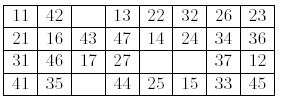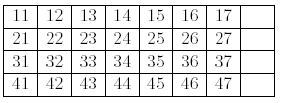POJ-2046---Gap (bfs+hash)
2017-08-28 14:37
399 查看
[align=center]Gap[/align]
Description
Let's play a card game called Gap.
You have 28 cards labeled with two-digit numbers. The first digit (from 1 to 4) represents the suit of the card, and the second digit (from 1 to 7) represents the value of the card.
First, you shu2e the cards and lay them face up on the table in four rows of seven cards, leaving a space of one card at the extreme left of each row. The following shows an example of initial layout.

Next, you remove all cards of value 1, and put them in the open space at the left end of the rows: "11" to the top row, "21" to the next, and so on.
Now you have 28 cards and four spaces, called gaps, in four rows and eight columns. You start moving cards from this layout.

At each move, you choose one of the four gaps and fill it with the successor of the left neighbor of the gap. The successor of a card is the next card in the same suit, when it exists. For instance the successor of "42" is "43", and "27" has no successor.
In the above layout, you can move "43" to the gap at the right of "42", or "36" to the gap at the right of "35". If you move "43", a new gap is generated to the right of "16". You cannot move any card to the right of a card of value 7, nor to the right of a
gap.
The goal of the game is, by choosing clever moves, to make four ascending sequences of the same suit, as follows.

Your task is to find the minimum number of moves to reach the goal layout.
Input
The input starts with a line containing the number of initial layouts that follow.
Each layout consists of five lines - a blank line and four lines which represent initial layouts of four rows. Each row has seven two-digit numbers which correspond to the cards.
Output
For each initial layout, produce a line with the minimum number of moves to reach the goal layout. Note that this number should not include the initial four moves of the cards of value 1. If there is no move sequence from the initial
layout to the goal layout, produce "-1".
Sample Input
Sample Output
题意:给出一个表,搜先把每行的第一个数移动到正确的位置,问你最少多少步能把输入的表变成目标状态(题中图3),移动到空位的数字必须满足比他前面一个数大1;
思路:很明显用到bfs去搜,关键书这么保存每个图的状态,看了一下学长博客,可以用hash来存,也可以用到map,hash也就是将每个图转变成了一个相应的值,每个图对应的hash值是不一样的,也可能出现相同的情况,那就需要用到一些其他的方法改进一下,但是这题我参照的学长的方法算的hash值不会出现上述的情况,构建函数感觉是很重要的一步。写的第一道用hash的题目~
AC代码:
#include<iostream>
#include<cstdio>
#include<cstring>
#include<algorithm>
#include<map>
#include<queue>
#include<stack>
#define mod 1000007
using namespace std;
typedef long long LL;
int mp[4][8];
LL Hash[mod];
LL base[32];
struct node
{
int mp[4][8];//存整个表
int tx[5],ty[5];//保存4个空
int step;//记录步数
}q,tmp;
queue<node> que;
int aim[4][8]={//目标状态
11,12,13,14,15,16,17,0,
21,22,23,24,25,26,27,0,
31,32,33,34,35,36,37,0,
41,42,43,44,45,46,47,0,
};
LL goal;//目标状态的hash值
void Getbase()
{
base[0]=1;
for(int i=1;i<32;i++)
base[i]=base[i-1]*2;
}
LL GetHash(int arr[4][8])//算每个状态的hash值
{
LL sum=0;
for(int i=0;i<4;i++){
for(int j=0;j<8;j++){
sum+=arr[i][j]*base[i*8+j];
}
}
return sum;
}
void change(node& t,int x,int y,int val,int k)//将某个点的值填到一个空位
{
for(int i=0;i<4;i++){
for(int j=0;j<8;j++){
if(t.mp[i][j]==val){
t.mp[i][j]=0;
t.mp[x][y]=val;
t.tx[k]=i;//记录新的空位
t.ty[k]=j;
return;
}
}
}
}
bool Insert_Hash(node q)//判断能否插入,判重
{
LL sum=GetHash(q.mp);
int v=sum%mod;
while(Hash[v]!=-1&&Hash[v]!=sum) v=(v+10)%mod;
if(Hash[v]==-1){Hash[v]=sum;return true;}
return false;
}
int bfs()
{
while(que.size())
{
tmp=que.front();
que.pop();
if(GetHash(tmp.mp)==goal) return tmp.step;//该点hash值和目标值相等,说明改状态即为目标状态,返回相应的值
for(int i=1;i<=4;i++)//循环4个空位
{
int pre=tmp.mp[tmp.tx[i]][tmp.ty[i]-1];
if(pre==0)continue;//该空位前面一个也是空点不行
if(pre%10==7)continue;//该空位前面一个是每行最大的数不行
q=tmp;
int tt=pre+1;
change(q,q.tx[i],q.ty[i],tt,i);
if(!Insert_Hash(q))continue;
q.step=tmp.step+1;
que.push(q);
}
}
return -1;
}
void init()
{
Getbase();
goal=GetHash(aim);
memset(Hash,-1,sizeof(Hash));
for(int i=0;i<4;i++){
for(int j=0;j<8;j++){
if(j==0){q.mp[i][j]=0;continue;}//每一行第一个点置为空点
scanf("%d",&q.mp[i][j]);
}
}
int cnt=0;
for(int i=0;i<4;i++){
for(int j=0;j<8;j++){//找到每行的第一个数
if(q.mp[i][j]==11&&j){
q.mp[0][0]=11;q.mp[i][j]=0;
q.tx[++cnt]=i;q.ty[cnt]=j;
}
if(q.mp[i][j]==21&&j){
q.mp[1][0]=21;q.mp[i][j]=0;
q.tx[++cnt]=i;q.ty[cnt]=j;
}
if(q.mp[i][j]==31&&j){
q.mp[2][0]=31;q.mp[i][j]=0;
q.tx[++cnt]=i;q.ty[cnt]=j;
}
if(q.mp[i][j]==41&&j){
q.mp[3][0]=41;q.mp[i][j]=0;
q.tx[++cnt]=i;q.ty[cnt]=j;
}
}
}
q.step=0;
que.push(q);
}
int main()
{
int t;
cin>>t;
while(t--)
{
init();
printf("%d\n",bfs());
while(que.size())que.pop();
}
return 0;
}
| Time Limit: 5000MS | Memory Limit: 65536K | |
| Total Submissions: 1943 | Accepted: 889 |
Let's play a card game called Gap.
You have 28 cards labeled with two-digit numbers. The first digit (from 1 to 4) represents the suit of the card, and the second digit (from 1 to 7) represents the value of the card.
First, you shu2e the cards and lay them face up on the table in four rows of seven cards, leaving a space of one card at the extreme left of each row. The following shows an example of initial layout.

Next, you remove all cards of value 1, and put them in the open space at the left end of the rows: "11" to the top row, "21" to the next, and so on.
Now you have 28 cards and four spaces, called gaps, in four rows and eight columns. You start moving cards from this layout.

At each move, you choose one of the four gaps and fill it with the successor of the left neighbor of the gap. The successor of a card is the next card in the same suit, when it exists. For instance the successor of "42" is "43", and "27" has no successor.
In the above layout, you can move "43" to the gap at the right of "42", or "36" to the gap at the right of "35". If you move "43", a new gap is generated to the right of "16". You cannot move any card to the right of a card of value 7, nor to the right of a
gap.
The goal of the game is, by choosing clever moves, to make four ascending sequences of the same suit, as follows.

Your task is to find the minimum number of moves to reach the goal layout.
Input
The input starts with a line containing the number of initial layouts that follow.
Each layout consists of five lines - a blank line and four lines which represent initial layouts of four rows. Each row has seven two-digit numbers which correspond to the cards.
Output
For each initial layout, produce a line with the minimum number of moves to reach the goal layout. Note that this number should not include the initial four moves of the cards of value 1. If there is no move sequence from the initial
layout to the goal layout, produce "-1".
Sample Input
4 12 13 14 15 16 17 21 22 23 24 25 26 27 31 32 33 34 35 36 37 41 42 43 44 45 46 47 11 26 31 13 44 21 24 42 17 45 23 25 41 36 11 46 34 14 12 37 32 47 16 43 27 35 22 33 15 17 12 16 13 15 14 11 27 22 26 23 25 24 21 37 32 36 33 35 34 31 47 42 46 43 45 44 41 27 14 22 35 32 46 33 13 17 36 24 44 21 15 43 16 45 47 23 11 26 25 37 41 34 42 12 31
Sample Output
0 33 60 -1
题意:给出一个表,搜先把每行的第一个数移动到正确的位置,问你最少多少步能把输入的表变成目标状态(题中图3),移动到空位的数字必须满足比他前面一个数大1;
思路:很明显用到bfs去搜,关键书这么保存每个图的状态,看了一下学长博客,可以用hash来存,也可以用到map,hash也就是将每个图转变成了一个相应的值,每个图对应的hash值是不一样的,也可能出现相同的情况,那就需要用到一些其他的方法改进一下,但是这题我参照的学长的方法算的hash值不会出现上述的情况,构建函数感觉是很重要的一步。写的第一道用hash的题目~
AC代码:
#include<iostream>
#include<cstdio>
#include<cstring>
#include<algorithm>
#include<map>
#include<queue>
#include<stack>
#define mod 1000007
using namespace std;
typedef long long LL;
int mp[4][8];
LL Hash[mod];
LL base[32];
struct node
{
int mp[4][8];//存整个表
int tx[5],ty[5];//保存4个空
int step;//记录步数
}q,tmp;
queue<node> que;
int aim[4][8]={//目标状态
11,12,13,14,15,16,17,0,
21,22,23,24,25,26,27,0,
31,32,33,34,35,36,37,0,
41,42,43,44,45,46,47,0,
};
LL goal;//目标状态的hash值
void Getbase()
{
base[0]=1;
for(int i=1;i<32;i++)
base[i]=base[i-1]*2;
}
LL GetHash(int arr[4][8])//算每个状态的hash值
{
LL sum=0;
for(int i=0;i<4;i++){
for(int j=0;j<8;j++){
sum+=arr[i][j]*base[i*8+j];
}
}
return sum;
}
void change(node& t,int x,int y,int val,int k)//将某个点的值填到一个空位
{
for(int i=0;i<4;i++){
for(int j=0;j<8;j++){
if(t.mp[i][j]==val){
t.mp[i][j]=0;
t.mp[x][y]=val;
t.tx[k]=i;//记录新的空位
t.ty[k]=j;
return;
}
}
}
}
bool Insert_Hash(node q)//判断能否插入,判重
{
LL sum=GetHash(q.mp);
int v=sum%mod;
while(Hash[v]!=-1&&Hash[v]!=sum) v=(v+10)%mod;
if(Hash[v]==-1){Hash[v]=sum;return true;}
return false;
}
int bfs()
{
while(que.size())
{
tmp=que.front();
que.pop();
if(GetHash(tmp.mp)==goal) return tmp.step;//该点hash值和目标值相等,说明改状态即为目标状态,返回相应的值
for(int i=1;i<=4;i++)//循环4个空位
{
int pre=tmp.mp[tmp.tx[i]][tmp.ty[i]-1];
if(pre==0)continue;//该空位前面一个也是空点不行
if(pre%10==7)continue;//该空位前面一个是每行最大的数不行
q=tmp;
int tt=pre+1;
change(q,q.tx[i],q.ty[i],tt,i);
if(!Insert_Hash(q))continue;
q.step=tmp.step+1;
que.push(q);
}
}
return -1;
}
void init()
{
Getbase();
goal=GetHash(aim);
memset(Hash,-1,sizeof(Hash));
for(int i=0;i<4;i++){
for(int j=0;j<8;j++){
if(j==0){q.mp[i][j]=0;continue;}//每一行第一个点置为空点
scanf("%d",&q.mp[i][j]);
}
}
int cnt=0;
for(int i=0;i<4;i++){
for(int j=0;j<8;j++){//找到每行的第一个数
if(q.mp[i][j]==11&&j){
q.mp[0][0]=11;q.mp[i][j]=0;
q.tx[++cnt]=i;q.ty[cnt]=j;
}
if(q.mp[i][j]==21&&j){
q.mp[1][0]=21;q.mp[i][j]=0;
q.tx[++cnt]=i;q.ty[cnt]=j;
}
if(q.mp[i][j]==31&&j){
q.mp[2][0]=31;q.mp[i][j]=0;
q.tx[++cnt]=i;q.ty[cnt]=j;
}
if(q.mp[i][j]==41&&j){
q.mp[3][0]=41;q.mp[i][j]=0;
q.tx[++cnt]=i;q.ty[cnt]=j;
}
}
}
q.step=0;
que.push(q);
}
int main()
{
int t;
cin>>t;
while(t--)
{
init();
printf("%d\n",bfs());
while(que.size())que.pop();
}
return 0;
}
相关文章推荐
- poj 2046 Gap(bfs+hash)
- hdu 1067 && poj 2046 Gap (bfs+hash)
- BFS+Hash(储存,判重) HDOJ 1067 Gap
- POJ-3985:Knight's Problem(特殊的bfs剪枝以及hash)
- POJ 2046 Gap BFS+哈希
- poj 2697 A Board Game(bfs+hash)
- hdu 1067 Gap bfs+hash
- POJ 1077 Eight(BFS Hash)
- hdoj1067 Gap(bfs+hash)
- hdu 1067 Gap+BFS+hash
- POJ 3131 Cubic Eight-Puzzle 双向BFS + HASH
- POJ 2046 Gap 笔记
- hdu 1067 Gap bfs+hash
- (*)[kuangbin带你飞]专题二 搜索进阶 H-Gap(bfs+hash)
- poj 2046 Gap
- poj 1077 bfs+hash(康托扩展)
- POJ 1324 Holedox Moving(bfs + hash)
- POJ 1482 HASH+BFS
- POJ Holedox Moving BFS hash判重
- HDU - 1067 Gap (bfs + hash) [kuangbin带你飞]专题二
